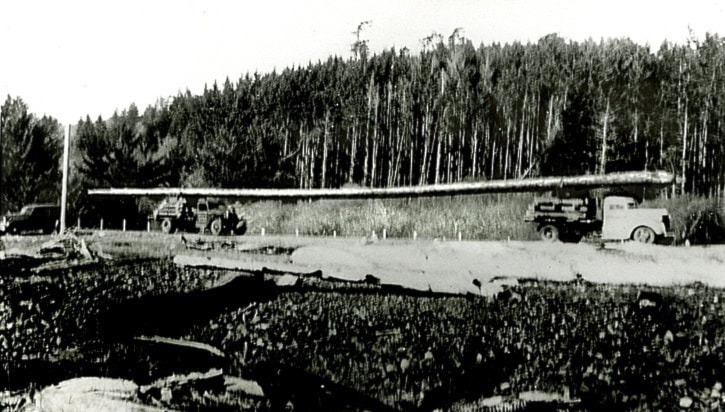Of fish traps and fir trees
The 150-foot long Douglas-fir pole seen here in the 1940s was not destined for a sawmill or for a foreign market. It was being hauled from among the majestic specimens that towered in the Muir Creek watershed to take its place as a piling driven into the ocean floor in the Strait of Juan de Fuca.
The enormous length of this piling required the utilization of two trucks to support it while being carried from the forest to the sea. While it is more than 50 years since the salmon fishtraps were installed each year to intercept fish on their way to their spawning rivers, the industry flourished for half a century.
Steam-powered piledrivers were used to drive piles into the water to form a fence that might extend half a mile into the Strait. When the incoming salmon reached the fence, which was lined with heavy-gauge wire mesh, their instinct drew them out to deeper water in an attempt to circumvent the barrier. Instead, they found themselves entangled in a maze from which there was no escape.
At the next “lift” of the traps, the salmon would be brailed out of the net into the hold of a fishpacker, and be on their way to canneries in Victoria, Steveston or Vancouver. Some of the springs went to the fresh market in Victoria and Seattle.
Generally five such traps were installed between Kirby Creek and Becher Bay each year. Before being overtaken by the rapidly mechanizing forest industry, this operation, first known in 1904 as J H Todd & Sons and later Sooke Harbour Fishing & Packing Co, was the mainstay of the area’s economy.
Piles such as this would be used at the deeper end of the barriers while much shorter ones were driven in graduated lengths closer to the shoreline. One can scarcely imagine the woodsmen’s skills needed to fell a tall slim Douglas-fir such as this, cushion its fall, then raise it to rest on supporting frameworks of two trucks, for its short journey to offload into the local waters.
Bert Acreman, working for G E Bernard, was one of the truck drivers hauling in this photo. Imagine if one were to see a sight like this along West Coast Road today!
Elida Peers,
Historian
Sooke Region Museum
